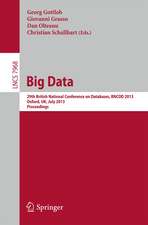Creating Good Data: A Guide to Dataset Structure and Data Representation
Autor Harry J. Foxwellen Limba Engleză Paperback – 2 oct 2020
Data analysts are often presented with datasets for exploration and study that are poorly designed, leading to difficulties in interpretation and to delays in producing meaningful results. Much data analytics training focuses on how to clean and transform datasets before serious analyses can even be started. Inappropriate or confusing representations, unit of measurement choices, coding errors, missing values, outliers, etc., can be avoided by using good dataset design and by understanding how data types determine the kinds of analyses which can be performed.
This book discusses the principles and best practices of dataset creation, and covers basic data types and their related appropriate statistics and visualizations. A key focus of the book is why certain data types are chosen for representing concepts and measurements, in contrast to the typical discussions of how to analyze a specific data type once it has been selected.
What You Will Learn
- Be aware of the principles of creating and collecting data
- Know the basic data types and representations
- Select data types, anticipating analysis goals
- Understand dataset structures and practices for analyzing and sharing
- Be guided by examples and use cases (good and bad)
- Use cleaning tools and methods to create good data
Who This Book Is For
Researchers who design studies and collect data and subsequently conduct and report the results of their analyses can use the best practices in this book to produce better descriptions and interpretations of their work. In addition, data analysts who explore and explain data of other researchers will be able to create better datasets.
Preț: 202.92 lei
Preț vechi: 253.65 lei
-20% Nou
Puncte Express: 304
Preț estimativ în valută:
38.83€ • 40.34$ • 32.26£
38.83€ • 40.34$ • 32.26£
Carte disponibilă
Livrare economică 13-27 ianuarie 25
Preluare comenzi: 021 569.72.76
Specificații
ISBN-13: 9781484261026
ISBN-10: 148426102X
Pagini: 105
Ilustrații: XV, 105 p. 16 illus.
Dimensiuni: 178 x 254 x 21 mm
Greutate: 0.23 kg
Ediția:1st ed.
Editura: Apress
Colecția Apress
Locul publicării:Berkeley, CA, United States
ISBN-10: 148426102X
Pagini: 105
Ilustrații: XV, 105 p. 16 illus.
Dimensiuni: 178 x 254 x 21 mm
Greutate: 0.23 kg
Ediția:1st ed.
Editura: Apress
Colecția Apress
Locul publicării:Berkeley, CA, United States
Cuprins
Chapter 1: The Need for Good Data.- Chapter 2: Basic Data Types and When to Use Them.- Chapter 3: Representing Quantitative Data.- Chapter 4: Planning Your Data Collection and Analysis.- Chapter 5: Good Datasets.- Chapter 6: Good Data Collection.- Chapter 7: Dataset Examples and Use Cases.- Chapter 8: Cleaning your Data.- Chapter 9: Good Data Anayltics.- Appendix A: Recommended Reading.
Recenzii
“The book is definitely valuable and anyone involved in statistical studies would do well to read it. The text could also be a useful tool in a graduate analysis course. The writing is clear and to the point, with no unnecessary ‘preaching’.” (James Van Speybroeck, Computing Reviews, September 2, 2021)
Notă biografică
Harry J. Foxwell is a professor. He teaches graduate data analytics courses at George Mason University in the department of Information Sciences and Technology and he designed the data analytics curricula for his university courses. He draws on his decades of experience as Principal System Engineer for Oracle and for other major IT companies to help his students understand the concepts, tools, and practices of big data projects. He is co-author of several books on operating systems administration. He is a US Army combat veteran, having served in Vietnam as a Platoon Sergeant in the First Infantry Division. He lives in Fairfax, Virginia with his wife Eileen and two bothersome cats.
Textul de pe ultima copertă
Create good data from the start, rather than fixing it after it is collected. By following the guidelines in this book, you will be able to conduct more effective analyses and produce timely presentations of research data.
Data analysts are often presented with datasets for exploration and study that are poorly designed, leading to difficulties in interpretation and to delays in producing meaningful results. Much data analytics training focuses on how to clean and transform datasets before serious analyses can even be started. Inappropriate or confusing representations, unit of measurement choices, coding errors, missing values, outliers, etc., can be avoided by using good dataset design and by understanding how data types determine the kinds of analyses which can be performed.
This book discusses the principles and best practices of dataset creation, and covers basic data types and their related appropriate statistics and visualizations. A key focus of thebook is why certain data types are chosen for representing concepts and measurements, in contrast to the typical discussions of how to analyze a specific data type once it has been selected.
You will:
This book discusses the principles and best practices of dataset creation, and covers basic data types and their related appropriate statistics and visualizations. A key focus of thebook is why certain data types are chosen for representing concepts and measurements, in contrast to the typical discussions of how to analyze a specific data type once it has been selected.
You will:
- Be aware of the principles of creating and collecting data
- Know the basic data types and representations
- Select data types, anticipating analysis goals
- Understand dataset structures and practices for analyzing and sharing
- Be guided by examples and use cases (good and bad)
- Use cleaning tools and methods to create good data
Caracteristici
Shows you how to clearly represent measurements, quantities, and characteristics relevant to research Teaches you how to avoid time-consuming data cleaning prior to analysis Permit clear and accurate statistical summaries and visualizations



























